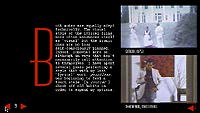



Charles Tashiro is Director of the New Literacy Project at the University of Southern California's Annenberg Center for Communication. A filmmaker for many years, he has also worked as a producer for the Voyager Company's Criterion Collection, a set of classic films on laser videodisc. It was while working at Voyager that Tashiro first became aware of the analytic and expressive potentials offered by digital media. In addition to the courier CD ROM, he has designed and produced several CDs for higher education. Tashiro is also a theorist of cinema and new media, whose work has appeared in Film Quarterly, Screen, Cinema Journal and other publications. His book Pretty Pictures: Production Design and the History Film was recently published by the University of Texas Press.
Conceptual Description
Very early on, cinema underwent a damaging split between production and criticism. While that basic division is true of all the arts, it is particularly egregious in popular art forms like film, television and video. At best this division has led to a willful ignorance on the parts of both producers and critics of the realities of the others' work. At worst it has contributed to the situation we have today: glorified public relations and a rarefied academic discourse, both equally devoid of production expertise or common sense on one side facing a rancid, decadent medium hostile to any model other than the one to which it is accustomed. The fine art venue for video has proven at best a mixed alternative to the Hollywood model, not much more than its negative image reflection. In the fine art world, highly variable work that answers to no standards beyond the artist's conscience and stated intentions is praised for no reason other than not being mainstream narrative.
The courier CD-ROM tries to bridge this gap by providing a complete video as well as critical commentary about it. While there are commerical examples of such combinations, the commentary has rarely been provided by the filmmaker himself and has never been cheaply produced. The falling price of CD-ROM manufacture, and the hardware and software necessary for their completion makes it possible for filmmakers to serve as their own critics and historians.
At one level, the courier CD-ROM is quite simply a means of distributing a video in new, hybrid form to audiences not hooked on Hollywood. Consumers of CD-ROMs tend to be more open-minded in their aesthetic expectations than traditional film or video audiences. They might therefore be more receptive to the half-experimental, half-narrative nature of the video itself. If the CD (or DVD) were nothing more than this, it would offer a new distribution medium for works that might otherwise have no exposure.
But the CD itself has become part of the artistic expression, a furthering of the experience, allowing makers of non-interactive, time-based media, such as film and video, the opportunity to extend their interests into interactivity. As they become their own commentators and historians, they invite users to view closed works like films and videos in the light of their intentions, while also opening up fields for debate.
While this first effort must remain provisional, I am pleased with the results. Bare minimum, it promises to allow the production process itself to become both an integral part of the final product and part of its reception.